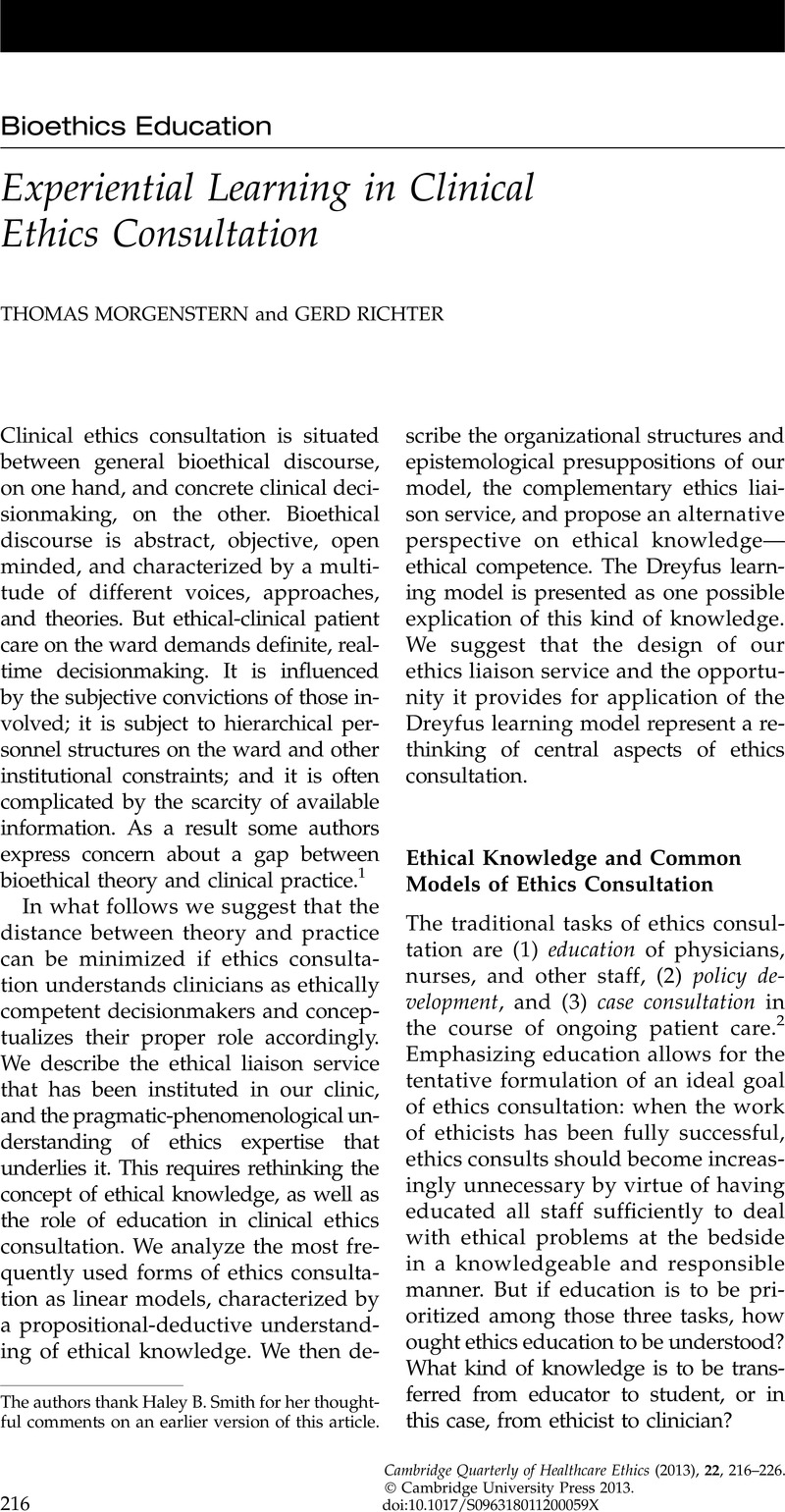Published online by Cambridge University Press: 14 March 2013

1 Cf. Richter, G.Greater patient, family and surrogate involvement in clinical ethics consultation: The model of clinical ethics liaison service as a measure for preventative ethics. HEC Forum 2007;19;327–40CrossRefGoogle ScholarPubMed; Richter, G.Clinical ethics liaison service: Concepts and experiences in collaboration with operative medicine. Cambridge Quarterly of Healthcare Ethics 2009;18:1–11CrossRefGoogle ScholarPubMed. See also Quante, M.Prinzipienlose Medizinethik? In: Düwell, M, Neumann, JN, eds. Wie viel Ethik verträgt die Medizin? Paderborn: Mentis; 2005:74–7.Google Scholar
2 Cf. Neitzke, G.Aufgaben und Modelle von Klinischer Ethikberatung. In: Dörries, A, Neitzke, G, Simon, A, Vollmann, J, eds. Klinische Ethikberatung: Ein Praxisbuch. Stuttgart: Kohlhammer; 2008:59.Google Scholar
3 See note 2, Neitzke 2008, at 62–71. Berkowitz, KA, Dubler, NN.Approaches to ethics consultation. In: Post, LF, Blustein, J, Dubler, NN. Handbook for Healthcare Ethics Committees. Baltimore, MD: John Hopkins University Press; 2007:140–2.Google Scholar
4 Compare the discussions of common models of ethics consultation by Neitzke and Berkowitz and Dubler. See note 2, Neitzke 2008, at 62–71; see note 3, Berkowitz, Dubler 2007, at 140–2.
5 See note 2, Neitzke 2008, at 64.
6 See note 2, Neitzke 2008, at 62–71. See note 3, Berkowitz, Dubler 2007, at 140–2.
7 An elaborated account and analysis of a linear model of bioethics is given by Krones, T.Kontextsensitive Bioethik: Wissenschaftstheorie und Medizin als Praxis. Frankfurt/New York: Campus; 2008, at 72–192Google Scholar, 307–12.
8 A detailed account is given by Richter. See note 1, Richter 2007 and Richter 2009.
9 Society for Health and Human Values–Society for Bioethics Consultation, Task Force on Standards for Bioethics Consultation. Core Competencies for Health Care Ethics Consultation: The Report of the American Society for Bioethics and Humanities. Glenview, IL: American Society of Bioethics and Humanities; 1998, at 6–7.
10 See note 1, Richter 2007 and Richter 2009; Richter, G.Klinischer Ethiker—der Ethik-Liaisondienst als Modell präventiver klinischer Ethikberatung. In: Baumann-Hölzle, R, Arn, C, eds. Ethiktransfer in Organisationen: Handbuch Ethik im Gesundheitswesen Bd.3. Basel: Schwabe, EMH; 2009:157–63.Google Scholar
11 Dewey, J.Human Nature and Conduct: An Introduction to Social Psychology. New York: H. Holt; 1922, at 177–8.Google Scholar
12 Miller, FG, Fins, JJ, Bacchetta, MD.Clinical pragmatism: John Dewey and clinical ethics. In: Miller, FG, ed. Frontiers in Bioethics: Essays Dedicated to John C. Fletcher. Hagerstown, MD: University Publishing Group; 2000:87–9.Google Scholar
13 Dewey, J.How We Think. Boston, MA: D.C. Heath; 1910, at 72CrossRefGoogle Scholar; cited in Miller et al. 2000, at 87, see note 12.
14 See note 12, Miller et al. 2000, at 87.
15 See note 12, Miller et al. 2000, at 95.
16 See note 12, Miller et al. 2000, at 94.
17 See Dreyfus, HL, Dreyfus, SE.Towards a phenomenology of ethical expertise. Human Studies 1991;15:229–50.CrossRefGoogle Scholar
18 See note 17, Dreyfus, Dreyfus 1991, at 232–6. In Dreyfus, HL.On the Internet. 2nd ed.London: Routledge; 2009, at 25–48Google Scholar, the author introduces a six-stage learning model (including the mastery level). In McPherson, I.Reflexive learning: Stages towards wisdom with Dreyfus. Educational Philosophy and Theory 2005;37:705–18CrossRefGoogle Scholar, McPherson discusses Hubert Dreyfus’s 2001 seven-stage account (including the level of practical wisdom). However, for our purposes we restrict ourselves to the more common five-stage learning model.
19 See note 17, Dreyfus, Dreyfus 1991, at 233–4.
20 See note 17, Dreyfus, Dreyfus 1991, at 234.
21 See note 17, Dreyfus, Dreyfus 1991, at 235.
22 See note 17, Dreyfus, Dreyfus 1991, at 236 (emphasis in the original).
23 See note 17, Dreyfus, Dreyfus 1991, at 237.
24 See note 17, Dreyfus, Dreyfus 1991, at 237 (emphasis in the original).
25 Aristotle. The Nichomachean Ethics. Book II, 4. Ross D, trans. New York: Oxford University Press; 1980; cited in Dreyfus, Dreyfus 1991, at 237, see note 17.
26 See note 17, Dreyfus, Dreyfus 1991, at 238.
27 See note 17, Dreyfus, Dreyfus 1991, at 238 (emphasis in the original).
28 See note 17, Dreyfus, Dreyfus 1991, at 241.
29 See note 17, Dreyfus, Dreyfus 1991, at 241.
30 See note 17, Dreyfus, Dreyfus 1991, at 241.
31 See note 17, Dreyfus, Dreyfus 1991, at 238.
32 Pena, A.The Dreyfus model of clinical problem-solving skills acquisition: A critical perspective. Medical Education Online 2010;15:10.3402/meo.v15i0.4846CrossRefGoogle ScholarPubMed; available at http://www.ncbi.nlm.nih.gov/pmc/articles/PMC2887319 (last accessed 9 Nov 2010).
33 See note 32, Pena 2010.
34 See note 32, Pena 2010; Carraccio, CL, Benson, BJ, Nixon, LJ, Derstine, PL.From the educational bench to the clinical bedside: Translating the Dreyfus developmental model to the learning of clinical skills. Academic Medicine 2008;83:761–7.CrossRefGoogle Scholar
35 Musschenga, AW.Moral intuitions, moral expertise and moral reasoning. Journal of Philosophy of Education 2009;43:597–613.CrossRefGoogle Scholar
36 See note 17, Dreyfus, Dreyfus 1991, at 235.